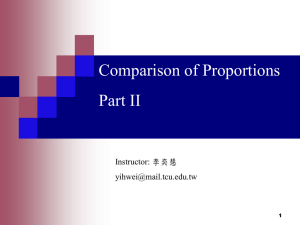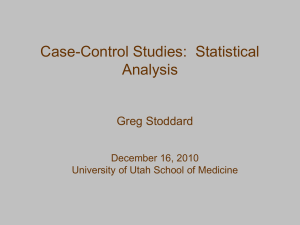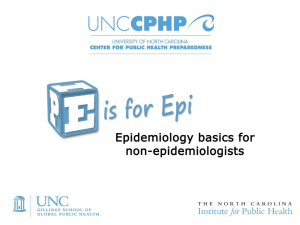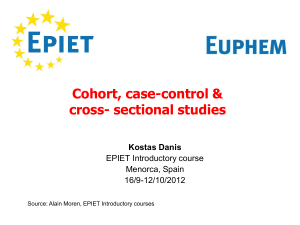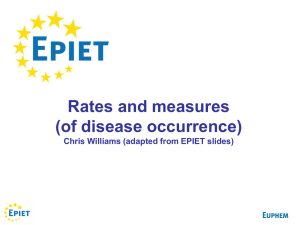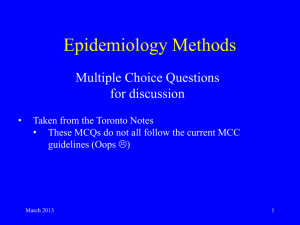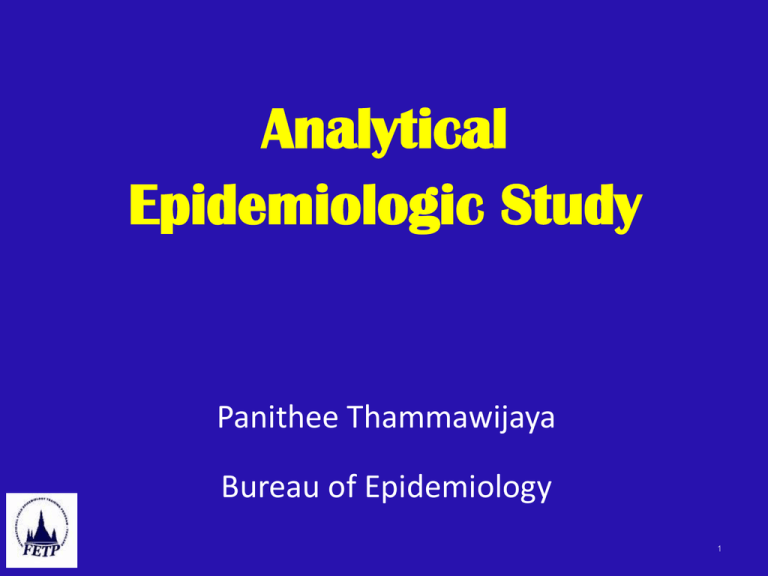
Analytical
Epidemiologic Study
Panithee Thammawijaya
Bureau of Epidemiology
1
เป้ าหมายของการศึกษาทางระบาดวิทยา
• DESCRIBE
Measure of Frequency
• มีผ้ ปู ่ วยด้ วยโรคหัวใจหลอดเลือดมากน้ อยเพียงใดในจังหวัดแห่งหนึง่
• ผู้ป่วยด้ วยโรคหัวใจหลอดเลือดเป็ นสัดส่วนเท่าไรในผู้หญิงและในผู้ชาย
• EXPLAIN
Measure of Association
• ทาไมผู้ชายจึงป่ วยด้ วยโรคหัวใจหลอดเลือดมากกว่าผู้หญิง
• การสูบบุหรี่ เพิ่มความเสี่ยงในการเป็ นโรคหัวใจหลอดเลือดหรื อไม่
• PREDICT
Measure of Impact
• ถ้ าสามารถรณรงค์ให้ คนในชุมชนเลิกสูบบุหรี่ ได้ เป็ นผลสาเร็จ จานวนผู้ป่วยโรคหัวใจ
หลอดเลือดรายใหม่ในปี หน้ าจะลดลงเป็ นจานวนเท่าไร
• CONTROL
• มาตรการที่เหมาะสมสาหรับชุมชน (ภายใต้ ข้อจากัดต่างๆ) คืออะไร
2
Source: Morgenstern, 2001 (modified)
การวัดทางระบาดวิทยา
• Measure of Frequency: ขนาดปัญหา
– ความชุก Prevalence
– อุบตั ิการ Incidence
• Measure of Association: วัดขนาดความสัมพันธ์ระหว่างปัจจัยกับ
โรค
– Risk Ratio, (Incidence) Rate Ratio ===> Cohort Study
– Odds Ratio ===> Case – Control Study
– Prevalence Ratio, Prevalence Odds Ratio ===> Cross-sectional
Study
3
From Last Time…(1)
If you want to count…
“State”
Prevalence
Existing of… at a point of time
(=New + Old cases)
E.g.
•Number of all DM cases a village in Jan 2009 = 120
•Proportion of current smokers in company on Jan 1st, 2010 =
15% of total employees
“Event”
Incidence
Occurring of… during a period of time
(=New cases)
E.g.
•Number of flu cases occurred in a village 2009 = 150
•Proportion of new smokers in a company during Jan to May
2010 = 2% of non-smoker on Dec 31st, 2009
From Last Time…(2)
Prevalence
Point Prevalence
=
At time t1
Period Prevalence
=
During
time t1-t2
= sick (old)
= sick (new)
= not sick
From Last Time…(3)
Incidence
Incidence Proportion
(Risk; Cumulative
Incidence )
Incidence Rate
During
time t1-t2
=
=
During
time t1-t2
(Rate; Incidence Density)
= person-time
= sick (old)
= sick (new)
= not sick
2x2 Table and Measure of Association
(Count Data)
Disease
Non disease
Total
Exposed
A
B
A+B
Unexposed
C
D
C+D
A+C
B+D
A+B+C+D
Total
Risk Ratio (RR) = [A/(A+B)] / [C/(C+D)]
Odds Ratio (OR) = [A/C] / [B/D] = AD/BC
Prevalence Ratio (PR) = [A/(A+B)] / [C/(C+D)]
7
2x2 Table and Measure of Association
(Person-Time Data)
No. of Cases
Person-Time
Exposed
A
TE
Unexposed
B
TU
A+B
TE+TU
Total
Incidence Rate Ratio (IRR) = [A/TE] / [B/TU ]
8
Ratio Scale Measures
and Theirs Relationships
0
OR
IRR
RR
Protective Effect
stronger
∞
1
weaker
RR
IRR
OR
Causative Effect
weaker
stronger
The null value
(no association)
Protective Factor
Risk Factor
Causative Factor
9
How epidemiologists work?
1. Counting:
Counts cases or health events, and describes
them in terms of time, place, and person
Descriptive
Epidemiology
2. Dividing:
Divides the number of cases by an
appropriate denominator to calculate “rates”
3. Comparing:
Compares these “rates” over time or for
different groups of people
* Rate, in this case, simply means division of one number by another
Analytic
Epidemiology
Classification epidemiological study
Observational Study
(natural exposure)
การศึกษาเชิงพรรณนา
Descriptive Study
(ไม่มีกลุ่มเปรี ยบเทียบ)
Case report Case series
Experimental Study
(exposure given by researcher)
การศึกษาเชิงวิเคราะห์
Analytic Study
(มีกลุ่มเปรี ยบเทียบ)
Cross – sectional
Case control
Cohort
11
From: Ram Rungsin, modified
ลำดับชั้นของกำรศึกษำทำงด้ ำนระบำดวิทยำ
Case report: a hypertension case in young adult
Descriptive
Case series: three hypertension cases in young adults
Cross – sectional study: a hypertension survey
Cross – sectional study: HT vs Salt consumption
Case – control study: HT vs Salt consumption
Cohort study: HT vs Salt consumption
Clinical trial: Beta blocker vs Hypertension
From: Ram Rungsin
Analytic
Experiment
12
การศึกษาเชิงพรรณนา
ไม่ป่วย
ผูป้ ่ วย
สนใจเฉพาะกลุ่มผูป้ ่ วย
เป้ าหมาย
Magnitude and severity
Distribution: Time, Place, Person
<<Hypothesis formulation>>
13
การศึกษาเชิงวิเคราะห์
ไม่ป่วย
ปัจจัย A?
ป่ วย
ปัจจัย A?
สนใจทั้งกลุ่มผูป้ ่ วย
และไม่ป่วย
เป้ าหมาย
Association between Disease and Factor A
<<Hypothesis testing>>
14
What Is the “Cause” of a Disease? (1)
Mr. A
• 20-yrs male, Thai, farmer, etc.
Counterfactual-not observed
1990
2010
Event actually occurred-observed
Mr. A
• 20-yrs male, Thai, farmer, etc.
Did pumpkin have an effect on the disease in Mr. A?
Yes, causative effect.
What Is the “Cause” of a Disease? (2)
Mr. A
• 20-yrs male, Thai, farmer, etc.
Counterfactual-not observed
1990
2010
Event actually occurred-observed
Mr. A
• 20-yrs male, Thai, farmer, etc.
Did pumpkin have an effect on the disease in Mr. A?
No. He is doomed.
What Is the “Cause” of a Disease? (3)
Mr. A
• 20-yrs male, Thai, farmer, etc.
Counterfactual-not observed
1990
2010
Event actually occurred-observed
Mr. A
• 20-yrs male, Thai, farmer, etc.
Did pumpkin have an effect on the disease in Mr. A?
No. He is immune.
What Is the “Cause” of a Disease? (4)
Mr. A
• 20-yrs male, Thai, farmer, etc.
Counterfactual-not observed
1990
2010
Event actually occurred-observed
Mr. A
• 20-yrs male, Thai, farmer, etc.
Did pumpkin have an effect on the disease in Mr. A?
Yes, protective effect.
Causal Inference in Modern Epidemiology
• วัดการเกิดโรคในกลุม่ ตัวอย่างกลุม่ หนึง่ ที่ “exposed” เปรี ยบเทียบ
กับการเกิดโรคในกลุม่ เดียวกัน(คนเดิม)นันหากว่
้
าพวกเขาไม่ได้
exposed , หรื อ
• วัดการเกิดโรคในกลุม่ ตัวอย่างกลุม่ หนึง่ ที่ “unexposed”
เปรี ยบเทียบกับการเกิดโรคในประชากรกลุม่ เดียวกัน(คนเดิม)นันหากว่
้
า
พวกเขาได้ exposed
• สรุ ป โดยหลักการ การศึกษาเพื่อค้ นหาสาเหตุ จะต้ องเปรี ยบเทียบ
“actual outcome” vs. “potential outcome”
19
Causal Inference in Modern Epidemiology
• ในทางปฏิบตั ิ เราไม่สามารถสังเกตการเกิดโรคในภาวะที่เป็ น
“counterfactual” หรื อ “the potential outcome” ได้
• เราจึงต้ องทาการเปรี ยบเทียบกลุม่ ตัวอย่างที่“exposed” กับกลุม่
ตัวอย่างอื่นแทน (Substitute population)
• กลุม่ ตัวอย่างอื่นที่ใช้ แทนได้ จะต้ องเป็ นกลุม่ ตัวอย่างที่มีลกั ษณะที่เป็ น
ตัวแทน(represent) ของ กลุม่ ตัวอย่างที่“exposed”นันหากว่
้
า
ไม่ได้ “exposed”
• Validity of inference ขึ ้นอยูว่ า่ กลุม่ ตัวอย่างที่นามาเปรี ยบเทียบ
กันนัน้ (exposed and unexposed groups) สามารถ
เปรี ยบเทียบกันได้ (comparability) มากน้ อยเพียงใด
20
What Is the “Cause” of a Disease?
Unexposed group
• age 15-25 yrs
1990
?
2010
Exposed group
• age 15-25 yrs
?
Did pumpkin have an effect on the disease in population? Validity & Precision?
Analytic Epidemiological Study
Exposure
Effect?
Association?
Cause?
Risk factor?
•ในทางปฏิบตั ิมกั จะไม่สามารถระบุได้
แน่ชดั ว่าสิ่ งใดเป็ นสาเหตุ (cause) ที่
แท้จริ งของโรคหนึ่งๆ เนื่องจากข้อจากัด
ของความรู้(เช่น ด้านชีววิทยาหรื อกลไก
การเกิดโรค เทคโนโลยีในการวัด ฯลฯ)
•ใช้คาว่า Risk factor แทนเพื่อแสดงถึง
ข้อจากัดดังกล่าว
Disease
•เป้ าหมายสาคัญของ Analytic study คือ การ
วัด effect ของ exposure ที่มีต่อโรคหนึ่งๆ
•ใน Observational study ไม่สามารถวัด
effect ได้โดยตรงเนื่องจากกลุ่มเปรี ยบเทียบ
อาจจะไม่ Comparable
•ในทางปฏิบตั ิจึงวัดได้แต่เพียง
ความสัมพันธ์(Statistical association)
22
กำรศึกษำเชิงวิเครำะห์
• Cross – sectional Study
• Case – Control Study
• Cohort Study
23
Cross-sectional study
In a cross-sectional study,
the measurements of exposure and
effect are made at the same time
24
สำรวจภำวะควำมดันโลหิตสู งและไขมันในเลือด
• The Health Department of Hanoi City in 2000
• 1,000,000 Hanoi population
• สัมภาษณ์
• เจาะเลือดวัด Cholesterol
• วัดความดันโลหิต
25
สำรวจภำวะควำมดันโลหิตสู งและไขมันในเลือด
• 60,000 = hypertension
• 200,000 = high blood cholesterol
• Prevalence of HT = ? 60,000/1,000,000 = 6%
“ ความดันโลหิ ตสูงและไขมันในเลือด
มีความสัมพันธ์กนั หรื อไม่ ”
26
สำรวจภำวะควำมดันโลหิตสู งและไขมันในเลือด
ID
Age
Sex
M
Hypertension
No
High
Chol
Yes
1
18
2
36
M
No
No
3
50
F
Yes
Yes
27
สำรวจภำวะควำมดันโลหิตสู งและไขมันในเลือด
Defined Population
Gather Data on Exposure & Disease at the same time
Exposed:
Exposed: Not Exposed: Not Exposed:
Have disease No disease Have disease No disease
28
สำรวจภำวะควำมดันโลหิตสู งและไขมันในเลือด
Disease
No Disease
Exposed
a
b
Not Exposed
c
d
29
สำรวจภำวะควำมดันโลหิตสู งและไขมันในเลือด
HT
No
HT
High Chol.
20,000
180,000
200,000
Normal Chol.
40,000
760,000
800,000
60,000,
940,000
1,000,000
30
สำรวจภำวะควำมดันโลหิตสู งและไขมันในเลือด
• High Cholesterol :
HT Prevalence Rate = 20,000 / 200,000 = 10%
• Normal Cholesterol :
HT Prevalence Rate = 40,000 / 800,000 = 5%
• Prevalence Ratio (PR) = 10% / 5% = 2
31
Prevalence Ratio (PR)
• Prevalence Ratio = 10% / 5% = 2
• แปลว่า “ ผูท้ ี่มีภาวะ high cholesterol มีโอกาสที่จะ
พบว่ามีโรคความดันโลหิ ตสูงอยูด่ ว้ ยเป็ น 2 เท่าของผูท้ ี่ไม่มี
high cholesterol”
PR จากการศึกษาแบบตัดขวาง สามารถใช้ประมาณค่า “Risk Ratio”
ถ้าหาก
•มัน่ ใจว่า Exposure เกิดก่อน Disease (No temporal ambiguity)
•Cases ที่อยูใ่ นการศึกษาเป็ นตัวแทนของ Incidence cases ทั้งหมด (ไม่
มี selective survival or prevalence-incidence bias)
32
Cross-sectional Studies
• Advantages:
– quick, inexpensive
– Useful for health administration and hypothesis
formulation
• Disadvantages:
– low prevalence due to
• Low incidence (rare disease)
• short duration
– Uncertain temporal relationships
– Selection Bias (Selective survival)
– Information Bias (Recall bias)
33
Cohort study
A study in which the
incidence proportion/rate of
disease in 2 or more cohorts
is compared
34
A Roman Cohort
= A unit of 300-600 men in the ancient Roman army
Two centuries made one maniple and three maniples made up one cohort.
35
“COHORT”
in Epidemiology
= A group of persons who
are followed over time
36
Cohort Study
• โดยทั่วไป ถือว่ าเป็ นการศึกษาแบบสังเกตที่
มีความถูกต้ องสูงสุดในแง่ การหา
ความสัมพันธ์ ระหว่ างปั จจัยกับการเกิดโรค
• ใช้ เวลาในการศึกษานานที่สุด
• ใช้ งบประมาณในการศึกษามากที่สุด
37
การใช้ระบาดวิทยาในการค้นหา
สาเหตุของการเกิดโรค
Cause
สำเหตุ
RISK FACTOR (ปัจจัยเสี่ ยง)
•Cigarette
Effect
ผล
DISEASE (การเกิดโรค)
•Lung Cancer
38
Person at-risk (without disease) at start
Exposed
เกิดโรค
ไม่เกิดโรค
Not Exposed
เกิดโรค
ไม่เกิดโรค
39
Persons without the disease !!!!
1970
Exposed
Not Exposed
Smoke
#500 persons
Not Smoke
#500 persons
Disease No Disease
2001
Disease
No Disease
Lung Cancer
No Lung Cancer
Lung Cancer
No Lung Cancer
# 45
# 455
#1
# 499
40
CA Lung No CA
Smoke
45
455
500
Not smoke
1
499
500
• Incidence of Smoker who develop Lung Cancer = 45/500
• Incidence of Non -Smoker whodevelop Lung Cancer = 1/500
• Risk Ratio of smoking for Lung Cancer = 45
• ผูท้ ี่สูบบุหรี่ มีโอกาสเกิดโรคมะเร็ งปอดมากกว่าผูท้ ี่ไม่สูบ 45 เท่า
41
Risk Ratio
CA Lung No CA
Smoke
A
B
A+B
Not smoke
C
D
C+D
Risk Ratio =
A/A+B
C/C+D
42
Conducting a Cohort Study
• เลือกประชากรกลุ่มที่ยงั ไม่เกิดโรคแต่มีโอกาส
• ค้นหา Exposed group และNon-exposed group
• ติดตามและวัด incidence of disease outcome ทั้งใน
กลุ่ม Exposed และ Non – exposed ระหว่าง ช่วงเวลาที่
ทาการศึกษา
• คานวณหา Risk Ratio หรื อ Incidence Rate Ratio
43
Design 1: Prospective Cohort Study
Time of Study Begin
Cause
Direction of inquiry
Effect
Disease
Population
Sampling?
People
without
disease
Exposed
No disease
Disease
Unexposed
No disease
•If the study started before the disease occurred…
44
“Prospective cohort study”
Ex: A Study of Smoking and Lung Cancer
(Prospective cohort study with person-time data)
No. of Case
F/U time (person-year)
Smoking
90
30,526
Non smoking
10
28,364
Total
100
58,890
Incidence rate in smokers = 90 / 30,526 = 2.9 per 1000 person-years
Incidence rate in non-smokers = 10 / 28,364 = 0.5 per 1000 person-years
Rate ratio = 2.9/0.5
= 5.8
Rate of developing the disease in smokers is 5.8
times of that in non-smokers
45
Design 2: Retrospective Cohort Study
Time of Study Begin
Cause
Direction of inquiry
Effect
Disease
Population
Sampling?
People
without
disease
Exposed
No disease
Disease
Unexposed
No disease
•If the study started after the disease occurred…
46
“Retrospective (Historical) cohort study”
Ex: An Diarrhea Outbreak in a Party
(Retrospective Cohort study with count data)
Ill
Not ill
Total
Ate salad
150
50
200
Not eat
10
90
100
Total
160
140
300
Incidence proportion in exposed group = 150 / 200 = 75%
Incidence proportion in non-exposed group = 10 / 100 = 10%
Risk ratio = 75/10
= 7.5
Risk of developing the disease in exposed group is
7.5 times of that in non-exposed group
47
Cohort Studies - Advantages
• Can measure disease incidence
• Can study the natural history
• Provides strong evidence of casual
association between E and D (time order
is known)
• Multiple diseases can be examined
• Good choice if exposure is rare
(assemble special exposure cohort)
• Generally less susceptible to bias
48
Cohort Studies - Disadvantages
• Takes time, need large samples,
expensive
• Not useful for rare diseases/outcomes
• With prolonged time period:
– Exposures change during follow-up period
• Selection Bias (loss-to-follow up in pros.
cohort or selective survival in retro.
cohort)
• Information Bias (recall bias in retro.
Cohort)
49
Case-control study
Key: it begins with people with the
disease (cases) and compares them to
people without the disease (controls)
50
Case – Control Study
เป็ นการศึกษาระบาดวิทยาเชิงวิเคราะห์ชนิดหนึ่ง เปรี ยบเทียบ
ระว่างผูท้ ี่เป็ นโรค (Case) กับกลุ่มตัวอย่างผูท้ ี่ไม่เป็ นโรค
(Control) โดยทาการเปรี ยบเทียบประวัติของลักษณะการมี
ปั จจัยเสี่ ยงที่กาลังศึกษา ระหว่าง 2 กลุ่ม
51
Case – control Study
Non Cases
Factor A
Cases
Factor A
Non Cases
Factor A
Cases
Factor A
52
Design for a case – control Study
Disease
Exposed
Not
Exposed
No Disease
Exposed
Not
Exposed
53
Design of a case-control study
Time of Study Begin
Cause
Direction of inquiry
Effect
Exposed
Case
(People with disease)
Case
Population
Controls
(People without disease)
Non-case
Population
Not exposed
Exposed
Not exposed
•Identify true case, and true non-case populations
•Sampling fractions from case<>non-case
•Determine exposure status by history
54
What is “Odds”?
Odds of an event with an occurrence probability of p
is the ratio of p to (1-p)
Odds = Probability of event
Probability of non-event
= p/(1-p)
Probability = odds/(1+odds)
+ D +
E
-
a
c
b
d
Head-to-Head = 9 : 18
For case-control study:
Odds of Exposure among cases = a/(a+c) = a/c
c/(a+c)
Odds of Exposure among noncases = b/(b+d) = b/d
d/(b+d)
What is “Odds Ratio”?
Odds Ratio (OR) = Ratio of two odds
In case-control study, Exposure OR
+ D +
E
-
a
c
b
d
= Odds of exposure among cases
Oddsof exposure among noncases
= a/c = ad/bc
b/d
For cohort study:
Odds of disease among the exposed = a/(a+b) = a/b
b/(a+b)
Odds of disease among the unexposed = c/(c+d) = c/d
d/(c+d)
In cohort study, Disease OR
= Odds of disease among the exposed
Odds of disease among the unexposed
= a/b = ad/bc
c/d
2x2 Table and Measure of Association
(Count Data)
Disease
Non disease
Total
Exposed
A
B
A+B
Unexposed
C
D
C+D
A+C
B+D
A+B+C+D
Total
Risk ratio (RR) = [A/(A+B)] / [C/(C+D)]
Odds ratio (OR) = [A/C] / [B/D] = [A/B] / [C/D]
If disease is rare, then OR ~ RR
57
Case-Control V.S. Cohort
Cause
Factors
Factors
Effect
Case – Control
Cohort
Disease
Disease
58
Conducting a Case-control Study
• ค้นหา “Cases”
• ทาการคัดเลือก “Controls” โดยเลือกจากกลุ่มประชากรที่
เป็ นแหล่งกาเนิดเดียวกันกับ Cases ในการศึกษา (study
base)
• วัดลักษณะการมีปัจจัยเสี่ ยง “ exposure ” ที่สนใจในกลุ่ม
cases และ controls
• เปรี ยบเทียบ exposure status ระหว่าง 2 กลุ่ม
• คานวณหา Odds Ratio
59
Sources of Cases
• Population-based (ผู้ป่วยในชุมชน)
• identify and enroll all incident cases from a defined
population
• e.g., disease registry, defined geographical area, vital records
• Hospital-based (ผู้ป่วยที่มารักษา)
– identify cases where you can find them
• e.g., hospitals, clinics.
– But……
• issue of representativeness?
• prevalent vs incident cases?
60
Sources of Controls
• Population-based Controls
• ideal, represents exposure distribution in
the general population, e.g.,
– driver’s license lists (16+)
– Medicare recipients (65+)
– Tax lists
– Voting lists
– Telephone RDD survey
61
Sources of Controls
• Hospital-based Controls
– Hospital-based case control studies used when
population-based studies not feasible
– More susceptible to bias
– Advantages
• similar to cases? (hospital use means similar SES, location)
• more likely to participate (they are sick)
• efficient (interview in hospital)
– Disadvantages
• they have disease?
– Don’t select if risk factor for their disease is similar to the
disease under study e.g., COPD and Lung CA
• are they representative of the study base?
62
Other Sources of Controls
• Relatives, Neighbors, Friends of Cases
– Advantages
• similar to cases wrt SES/ education/ neighborhood
• more willing to co-operate
– Disadvantages
• more time consuming
• cases may not be willing to give information?
• may have similar risk factors (e.g., smoke, alcohol,
golf)
63
Case : Control Ratio
• อัตราส่ วนของ case : control โดยทัว่ ไปอยูร่ ะหว่าง 1:1 ถึง 1:4
• ถ้าจานวน case เท่าเดิม
– การเพิ่มจานวน control จะช่วยเพิ่ม precision ของ Odds ratio
– แต่การเพิ่มจานวน control ให้มากกว่า 4 ต่อ 1 case พบว่าไม่ได้เพิ่ม precision มาก
เท่าไรและอาจไม่คุม้ กับต้นทุนที่เพิ่มขึ้น
• ถ้าจานวนรวมของ Case กับ Control คงที่
– อัตราส่ วน 1:1 จะทาให้ได้ precision ของ Odds ratio มากที่สุด
64
Ex: Smoking and Lung Cancer
Controls
Cases
Lung Cancer
NO Lung Cancer
#50 cases
#200 controls
Exposed Unexposed
Smoke Not Smoke
Exposed Unexposed
Smoke Not Smoke
# 45
#5
# 99
# 101
65
Cohort Study
RR = (500/10000)/(100/9900)
=5
OR = (500/9500)/(100/9900)
= 5.2
Smoke
Not smoke
Case – Control Study
Smoke
OR = (50/10)/(95/99)
= 5.2
Not smoke
CA Lung
No CA
500
9,500
10,000
9,900
10,000
100
CA Lung
No CA
50
95
10
99
• Do not have incidence in exposed & incidence in non exposed
• Cannot calculate the RR directly
66
Ex: A Food Poisoning in a School (1)
(Case-control study)
Case
Control
Ate ice cream
40
17
Not eat
15
38
55
55
Total
Odds of eating ice cream in cases = (40/55) / (15/55) = 40/15
= 2.67
Odds of eating ice cream in control = (17/55) / (38/55) = 17/38
= 0.45
Odds ratio = 2.67 / 0.45 = 5.9
67
Ex: A Food Poisoning in a School (2)
(Case-control study)
How to interpret odds ratio of 5.9 ???
In conventional case-control study: case vs. non-case
1. Study cases represent cases in population
2. Study control represent non-case in population
>>> OR of 5.9 means “Odds of disease among the exposed
is 5.9 times of that among the unexposed”
If 1.+2.+ 3. Rare disease
>>> OR ≈ RR
In population-based case-control study:
• With case-cohort sampling
>>> OR = RR
•
>>> OR = IRR
With density sampling
68
Case-control Study - Advantages
• Quick and cheap (relatively)
– so ideal for outbreaks
• Can study rare diseases (or new)
• Can evaluate multiple exposures
69
Case-control Study - Disadvantages
• uncertain of Exposure-Disease relationship
(esp. timing)
• cannot estimate disease incidence
• inefficient if exposures are rare
• Selection Bias
– Much worry about representativeness of
controls
– selective survival if not using incidence cases
• Information Bias (recall bias)
70
71
Acknowledgement
•
•
•
•
Dr. Chuleeporn Jiraphongsa
Dr. Ram Rungsin
Dr. Darin Areechokchai
Dr. Mathew J. Reeves
72



